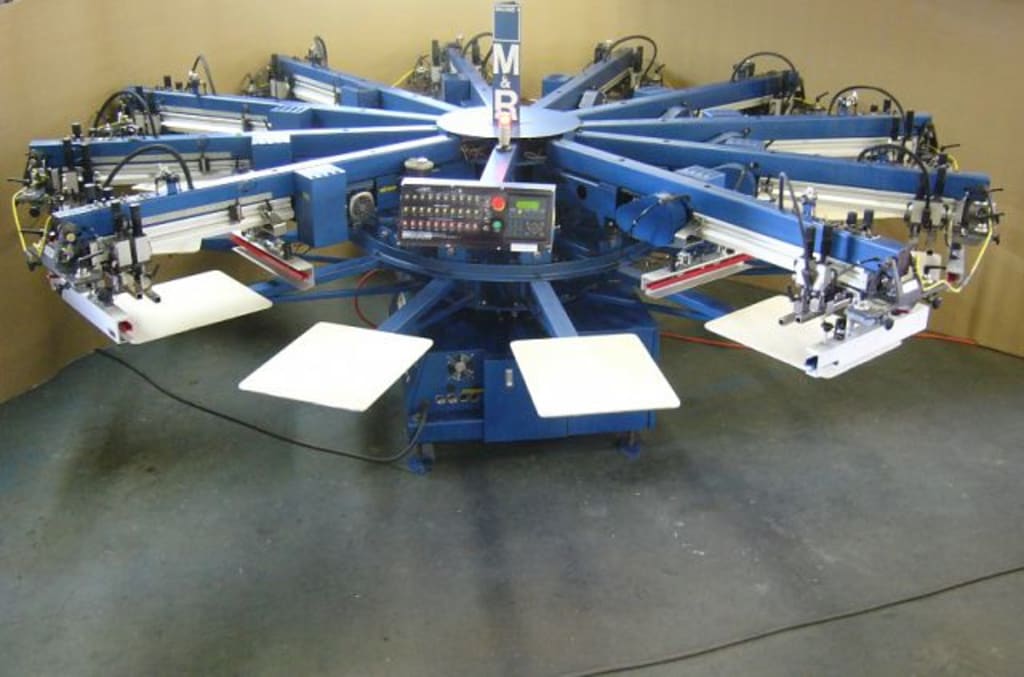A guide to screen printing equipment
Advantage to Warm Transfer Printing Machine

If you want to obtain a tidy, sharp print, a screen printer must have the right tools for the task. Right here, we'll discuss every piece of screen printing machine tools, including what features they serve throughout the printing procedure.
Screen printing press
When it is possible to screen print with just a mesh screen and a squeegee, many printers choose to use a press, as it enables them to publish lots of items much more successfully. That is because journalism holds the screen in position between prints, making it easier for the user to switch out the paper or apparel getting printed.
There are three sorts of the press: manual, semi-automatic, and also automatic. Hands-on presses are run by hand, implying they're instead work-intensive. Semi-automatic presses are partly mechanized yet still need human input to swap over the things getting pressed. In contrast, automated presses get entirely automated as well as call for little to no information.
Companies that require to print items in massive amounts will typically use a semi- or completely automated press, as this allows much faster, more efficient printing and reduces blunders. Smaller companies, or those that do screen printing as a hobby, may locate that a hand-operated table-top press (often called a 'hand bench' press) gets far better matched to their needs.
The inks
The ink, paint, or pigment is pressed through the mesh screen and onto the item, getting published, transferring a colored imprint of the pattern layout onto the object.
There's far more to choosing an ink than just selecting a color. There are lots of specialist inks that you can use to produce various finished items. For example, a printer may use glittery inks, texturized inks, or smoke inks (which broaden to have an increased surface area) to create a distinct appearance or feel. The printer will certainly think about the kind of material being screen published, as some inks will work better on specific products than others.
When printing garments, printers will use a sort of ink that ends up being maker washable once it has been heat-treated and set. That produces a colorfast, long-wearing thing that can get worn repeatedly.
The silkscreen
In T-shirt screen printing machine, the silkscreen is a metal or wooden framework with a lavish mesh material stretched over the top. Typically, this mesh got crafted from silk thread. However, nowadays, polyester fabrics have been superseded, which offer the same performance for a lower cost. You can choose the mesh's thickness and thread matter to suit the surface area's texture or material, with smaller sized rooms between strings allowing for greater detail in print.
As soon as the screen gets coated in solution and subjected, it prepares to get used as a pattern. After the screen printing process has ended up, you can wash it and re-use.
The squeegee:
A squeegee is a rubber blade joined to a long wood, metal, or plastic for taking care. It is to press the ink through the mesh screen and onto the surface area published. The printer will generally pick a squeegee that is a comparable size to the screen framework, as this will offer better protection.
A more robust rubber blade is much better for printing intricate layouts with lots of information, as it guarantees all the spaces and crannies in the stencil, obtain an even layer of ink. A softer, more yielding rubber squeegee that you usually utilize when printing much less comprehensive layouts or printing onto fabric.
The washing terminal
The displays require to get washed to eliminate all traces of emulsion after usage so that you can re-use them once again for future prints. Some larger print works might use large bathtubs of special cleaning liquid or acid to eliminate the emulsion. At the same time, other printers merely use a water trough or sink and a power tube to cleanse their displays.
Frequently Asked Question:
Will screen printing ink rinse?
If a garment gets effectively screened by trained professionals using heat-treated washable ink, then the style shouldn't rinse. To ensure a colorfast coating, the printer must see to it that the ink you establish according to the maker's guidelines. The correct drying temperature level and time vary depending on the type of ink and the fabric used, so the printer needs to follow the letter's instructions if they wish to produce a durable, washable item.
What is the distinction between screen printing and also electronic printing?
Straight to garment (DTG) electronic screen printing machine utilizes a specialist textile printer-- a little bit like an inkjet computer system printer-- to transfer an image directly onto fabric. It varies from screen printing since you use an electronic printer to move the style straight onto the material. Because there's no pattern, numerous colors can be used simultaneously, instead of in separate layers, suggesting this method is often used to publish detailed or very colorful layouts.
Unlike screen printing, there's minimal configuration required, which means that digital printing is a much more cost-efficient alternative for printing tiny batches of garments or single items. Also, because it uses a computerized picture instead of a stencil, it's beautiful to create photographic or highly comprehensive designs. Nonetheless, the colors you print using CMYK-style dots of color, instead of concrete blocks of ink, don't offer the same intensity of color you get with screen printing. You can not create texturized effects with a digital printer, either.
What's the distinction between silkscreen printing & heat transfer?
Heat press printing machine is the name addressed to any printing that uses warm to bind a layout to a textile—the style you published out onto a material covered with heat-reactive glue, called transfer or sublimation paper. When a warmth press you apply to the transfer paper, the sticky responds to the warmth and adheres to the surface area of the textile beneath, developing a printed fabric.
Heat transfer printing is effortless and inexpensive, so it's excellent for smaller sized sets of personalized printing. You can also use it to move detailed photographic designs, which screen printing can not do. Digital transfer printing can also get terrific outcomes on products like bags, hats, or footwear, which can be tricky to screen print due to their awkward shape.
It's also possible to combine the warm transfer process with digital strategies to obtain both globes' best. With electronic best heat transfer printing machine, a style is created using a computer system software application and printed onto white transfer paper. After that, the design removed, using a machine called a plotter, which complies with a digital outline to get accurate results. The finished transfer you place on the wanted area on the garment or accessory. After that heat-treated, you bind it to the textile.
Suppose there's a disadvantage to warm transfer printing. In that case, the quality can differ significantly depending on the materials utilized, individual printers using shoddy methods, and low-quality products that have given it something of a low online reputation in the last few years. Yet, as long the right transfer product is used and the style you use with treatment, the resulting garment will certainly be a premium, durable item.
About the Creator
Angelica Milli
Hi, I am a professional digital marketer in the global world.






Comments
There are no comments for this story
Be the first to respond and start the conversation.